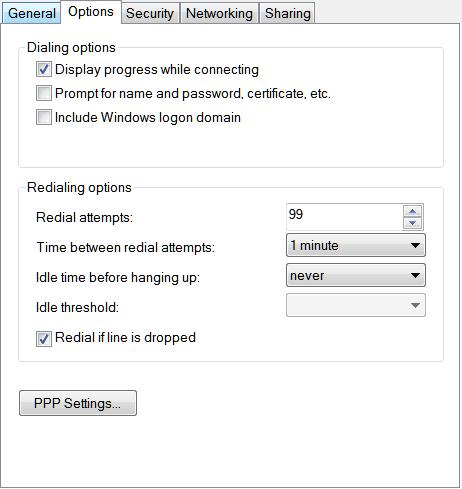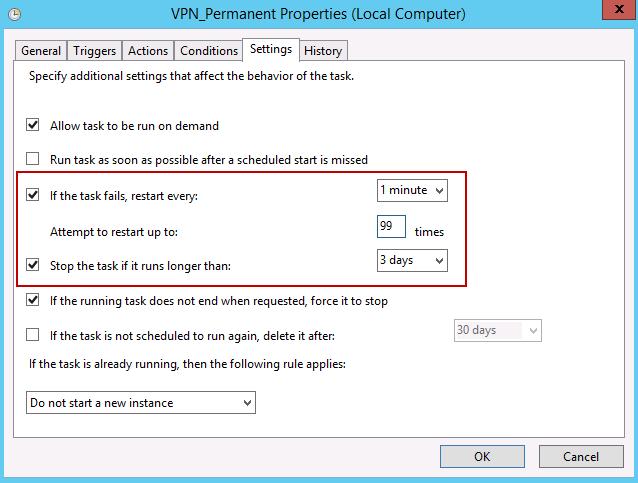Перезвонить при обрыве связи windows 10
Сообщения: 10
Благодарности: 1
prosto user, Высокоскоростное (с PPPoE) (Подключение через DSL или кабель требующее ввода имени пользователя и пароля)
Подключаюсь от имени администратора
Время простоя никогда
На предыдущих версиях Windows была возможность автоматически переподключаться при разрыве, и там показывалось, что соединение оборвано (Я пользуюсь одним интернетом с человеком и когда обе сессии активны подключение обрывается каждые пол часа), а тут, просто интернет отключается никак не уведомляя меня об этом и нет такои опции для перезвона, может можно как то ее активировать? Или попробовать заменить rasphone.exe на версию от Windows 7, на сколько я понял именно эта программа отвечает за подключение к интернету.
| Конфигурация компьютера | |
| Материнская плата: Asus P8Z77-M (1 PCI, 1 PCI-E x1, 2 PCI-E x16, 4 DDR3 DIMM, Audio, Video, Gigabit LAN) | |
| HDD: Samsung SSD 860 EVO 250GB | |
| Звук: Realtek ALC887 @ Intel Panther Point PCH — High Definition Audio Controller [C-1] | |
| CD/DVD: Optiarc DVD RW AD-7280S (DVD+R9:12x, DVD-R9:12x, DVD+RW:24x/8x, DVD-RW:24x/6x, DVD-RAM:12x, DVD-ROM:16x, CD:48x/32x/48x DVD+RW/DVD-RW/DVD-RAM) | |
| ОС: Windows 8 Professional х64 |
Или попробовать заменить rasphone.exe на версию от Windows 7, »
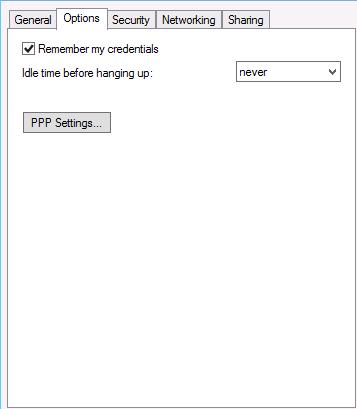
Методов несколько. Давайте по порядку. По мере возрастания, так сказать, сложности.
Метод 1 — используем Notepad:
Установить нужные параметры вручную. Для этого необходимо перейти в папку
C:Users[USER]AppDataRoamingMicrosoftNetworkConnectionsPbk
Найти там (скорее всего единственный) файлик с именем rasphone.pbk. Это обычный текстовый файл, содерржащий настройки подключения к VPN
Файл можно открыть с помощью notepad.exe (Блокнот)
В общем случае, необходимо отыскать секцию, содержащую ваш VPN – например, такой [PPTP-VPN]
А в ней отыскать строки (TADA!)/ Если ничего не меняли, то выглядеть будет примерно так:
То есть опять “Microsoft за вас подумали и все решил”.
Но теперь вы знаете, где искать и менять необходимые параметры.
- RedialAttempts=3 – количество попыток пере-подключиться (максимум 99)
- RedialSeconds=60 – количество секунд между попытками пере-подключиться
- IdleDisconnectSeconds=0 — сколько выжидать, чтобы понять что линия оборвалась (0 – не ждать вовсе)
- RedialOnLinkFailure=1 — Перенабрать, если связь оборвалась? 1 – да, 0 — нет
Чтобы параметры применились, необходимо, как и раньше, переподключить VPN.
А потом верить, что Microsoft Windows все сделает за вас 🙂
Метод 2 – настраиваем простейшую задачу:
Создать в Task Scheduler задачу, которая будет запускать bat-файл со строкой подключения к необходимому VPN и настроить эту задачу, на запуск, скажем, каждые 5 минут.
Напомню, командная строка для подключения VPN соединения выглядит так
C:windowssystem32rasdial.EXE entryname [username [password|*]] [/DOMAIN:domain]
Там еще параметры есть, но их, если интересно, посмотрите сами.
В задаче не забываем указать, что “запускать всегда”
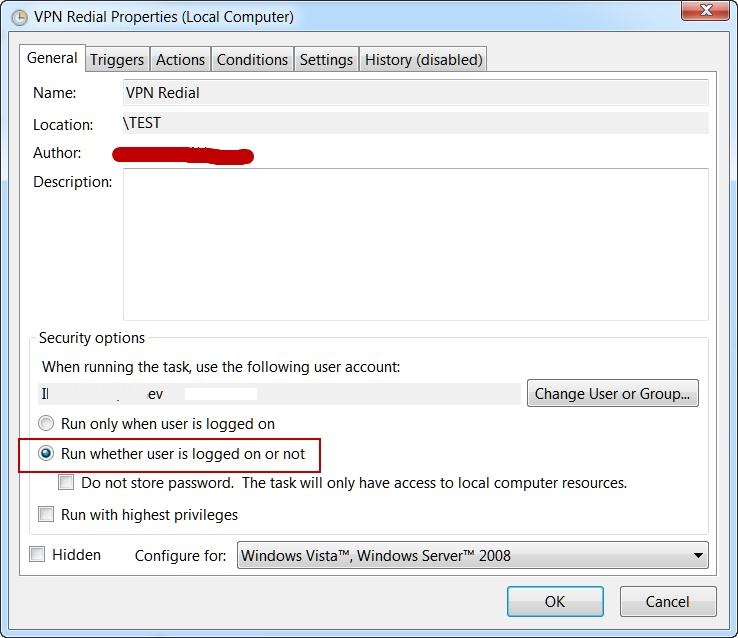
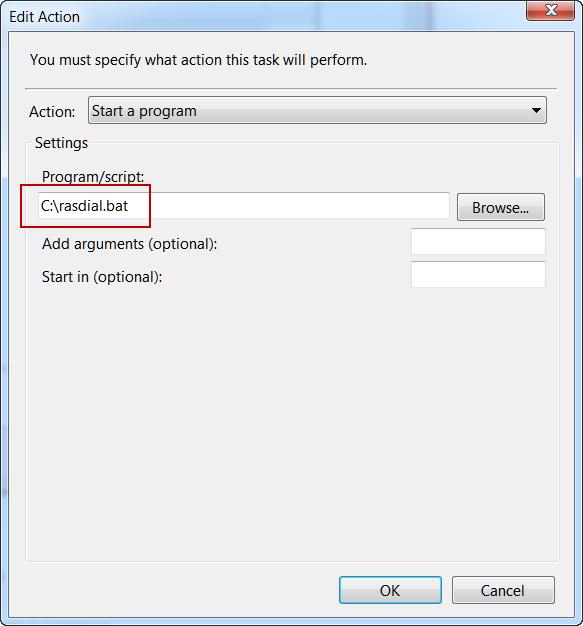
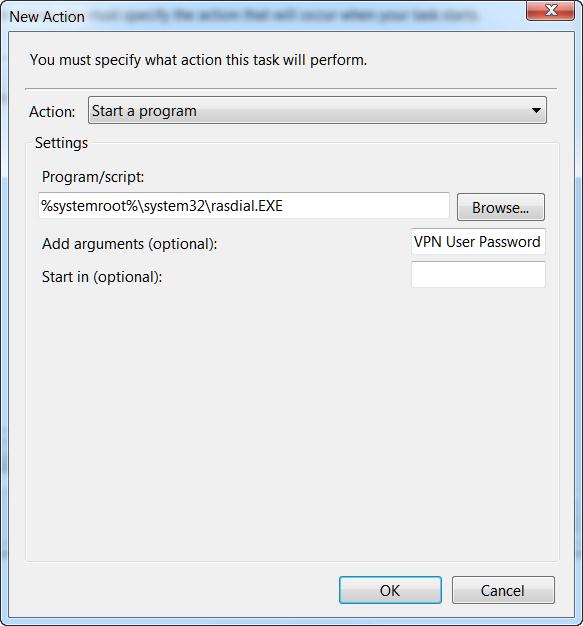

- Создаем задачу в Task Scheduler
- Определяем в задаче два триггера. Один с использованием XML запроса (по аналогии со статьей Запуск задания планировщика после завершения определенного задания)
- Название лога: Microsoft-Windows-NetworkProfile/Operational
- Источник : NetworkProfile
- Event ID: 10000
- В качестве запускаемой программы, выбираем rasdial.exe с параметрами vpn-name username password
- Дополнительно, на вкладке Conditions, можно доопределить следующие параметры
Ну вот, собственно и все.
Далее под спойлером привожу, без перевода, длинное, подробное и нудное описание Метода 1 и 3 на английском языке, взятое с форума Technet.
Had this problem for a few weeks but finally got a chance to spend some time on it last night. Came across this thread….My guess is that with Microsoft making the VPN connection RT-Like, they missed part of the dialog or put it that way for RT Tablets with the thought that you wouldn’t want the VPN reconnecting and using up data/battery. Of course they missed the point of keeping it for desktops…..
Anyways I was hoping that the dialogs info was missed by the actual code wasn’t as is the case sometimes. Looked promising when I checked the VPN config and found the settings generated in a Windows 8 connection. Unfortunately while the settings are enabled for redial, the redial function doesn’t work. I tried establishing a VPN connection with rasdial though dos but still no luck. Just occurred to me as I’m typing this email that I may try renaming the rasdial.pbk and loading it with the Rasdial comment to establish a VPN connection, maybe it will use the settings. Will give it a try later.
The C:UsersJoeAppDataRoamingMicrosoftNetworkConnectionsPbkrasphone.pbk actually has the redial settings enabled in it…
RedialAttempts=3
RedialSeconds=60
IdleDisconnectSeconds=0
RedialOnLinkFailure=1 (This is set to one in Windows 7 when you enable the Redial checkbox)
In case anyone is interested, came up with a fairly good workaround last night until MS releases an update to put the settings back. I like this solution better than running a 3rd party solution to try to keep the VPN up. You can setup a Task Schedule job to trigger on a disconnect. I gave it a try last night and the VPN immediately reconnected. I’m checking for client/remote disconnect error codes excluding the «user disconnect» code to avoid it reconnecting when you actually want to disconnect. These are just two error codes I noted in the event log, MS lists a lot more error codes but I haven’t experienced them on disconnects though they could be added. If anyone uses this and thinks more codes should be added please update the xml query or let me know and I’ll update it. Forgive the XML query, not something I usually do so if it can be formatted better, let me know…for learning 😉
Here is a list of some error codes (this is not complete for Win8 but I didn’t spend much time searching)
How to setup a Scheduled Task to Trigger on a VPN Disconnect
- Click Windows8 Start and type Schedule Task (open it under Settings)
- Click Create Task
- Apply the following settings in the specified Tabs (italics describes each setting)
General Tab
Name: VPN Redial
For descriptive use, you can use any name you want like My Company VPN Redial….whatever…..
Select: Run whether user is logged on or not
Provided you have a password associated to your login account, this option will prevent the dos window from opening everytime the job runs. If you don’t have a password, leave it and see the notes below these steps.
Triggers Tab
Click New button
To create a new trigger we will use to activate the job when the VPN connect disconnects
Begin the task: On an Event
The job will be triggered by an Application event log entry
Select: Custom
Custom gives us the flexibility of creating a more detailed query
Click New Event Filter… button
Here is where we build the query for the trigger
Click the XML tab
This tab allows us to write our own query (even more flexible)
Check Edit query manually
To start a manual edit
Copy the following query
This query will trigger on an Application Event for RasClient with an EventID of 20226 and error codes 829 (Remote Disconnect), 629 (Client Disconnect). Copy from and including to
Ensure Enabled is checked
Check it if it’s not checked to make sure the job will be enabled
Actions Tab
Click New
To create an action to be performed when the job is triggered
Action: Start a program
Selection this option will allow us to start rasdial to reestablish the VPN connection
Program/script: rasdial
Should already be in path so just enter rasdial command
Add arguments (optional): «VPN Name» username password
VPN name is the name you defined for your dialup connection. Example, when you click the network icon in the system tray, the name that’s listed for your VPN, make sure you enter it in exactly as displayed. Following the connect would be your username and password. Example, «MY VPN Connection» username password
Conditions Tab (not required unless you are using a laptop)
Uncheck: Stop if the computer switches to battery power
Settings TAB
Enable: If the task fails, restart every: 1 minute
In case there is a temporary issue re-establishing the VPN connection. You can specify whatever value you want instead of 1 minute
Attempt to restart up to: 7 times
Again in case there is a temporary issue re-establishing the VPN connection. You can specify whatever value you want instead of 7 times
Click Ok
Notes
- Haven’t really tested this much but I had configured it last night, woke up this morning to find the Event log showing 4 disconnects, and the job redialed all 4 times, VPN connection was still active.
- In the General Tab we enabled «Run whether user is logged on or not. This is a non issue since there won’t be a VPN connection when you’re not logged in. What this option does since we are running a dos (rasdial) command, it prevent a dos window from opening every time the job runs so you won’t be distracted if you’re in the middle of something. This option only works if you have a password (which you should) associated with your account. If you don’t and just allow your computer to boot to desktop, the option won’t work. What I’ve done for people in these situations is created a little VBScript wrapper to launch the dos command to avoid the dos prompt. Not really an issue unless you’re anal about it like me, you could simply deal with the Dos window opening up.
- Again the query checks the event log for a new Entry for RasClient with an event id of 20226 containing error codes 820 or 620. you can add additional error codes by repeating the pattern. Example to also trigger on 222 and 333 you would modify the relevant part of the line as such *[EventData[Data[4]=’829′ or ‘629’ or ‘222’ or ‘333’]]
4. I’m checking error codes because I don’t want the job to be reconnected if I purposely disconnect the VPN which generates a 631 code under Event ID 20226.
Adblock
detector
Теперь убрали практически все и оставили только:
Привет
У меня PCI-модем с телефонной линией, который работает круглосуточно.
Дело в том, что меня часто не бывает дома и требуется интернет в подключенном состоянии.
Я пытался найти звонилку под ОС Windows 10, но всё бесполезно — всё звонилки не могут «поймать» CALLBACK !
Я решил воспользоваться старым проверенным скриптом, который мне подарили здесь на этом форуме 2 года назад:
| Windows Batch file | ||
|
только есть одна просьба к специалистам в этом деле:
Вы не можете доработать для меня вышеприведённый код и довести его до состояния, при котором
вместо выключения ПК (shutdown) происходит вызов встроенной процедуры дозвона Windows 10
т.е. необходимо из BAT-файла вызвать стандартную звонилку Windows 10
это первое, что я хотел бы попросить ^^^^^^
есть ещё одна маленькая просьба (чтобы не спамить на форуме):
при старте ОС «Windows 10» автоматически стартует браузер установленный по-умолчанию «Mozilla Firefox 45.0.1»
запуск различных утилит по настройке (в том числе и Msconfig) ни к чему не приводит
Если кто знает, как убрать Firefox из автозапуска, прошу поделиться в данной ветке.
Всем заранее спс.
__________________
Помощь в написании контрольных, курсовых и дипломных работ, диссертаций здесь
Какая еще автозагрузка cmd-файлов для обычного пользователя?
Проблема тут далеко не в галочках и паролях, а в разрывах соединения, которых быть не должно в принципе.
А они на самом деле очень и очень существенные.
По теме.
21 числа в 00:12 с вашего порта начался очень обильный broadcast flood, который не прекращается и по сею минуту.
То есть ваш компьютер непрерывно генерирует большое количество трафика, предназначенного для всей подсети вашего района, что не есть нормально.
Возможные причины флуда:
-NetBIOS-трафик, отключается в настройках подключения по локальной сети (Протокол Интернета TCP/IP — Свойства — Дополнительно — WINS — Отключить NetBIOS через TCP/IP);
-Сервисы SSDP (UPnP)
-P2P-клиенты могут искать пиров в локальной сети при определённых обстоятельствах. Отключение функции «Поиск локальных пиров» находится в настройках торрент-клиента (для uTorrent: Настройки — Конфигурация — Bittorrent / Settings — Configuration — Bittorrent);
-Windows Vista и Windows 7 со включенным IPv6;
-Некоторые сетевые игры;
-Сервис Bonjour, устанавливаемый с некоторыми продуктами Adobe;
-Некоторые кривые сетевые карты и их драйверы;
-Вирусы;
Вспомните, что происходило с компьютером в это время (21 числа в 00:12).
И избавьтесь от этого, все придет в норму.

